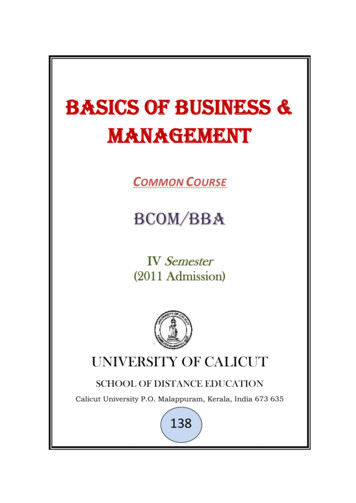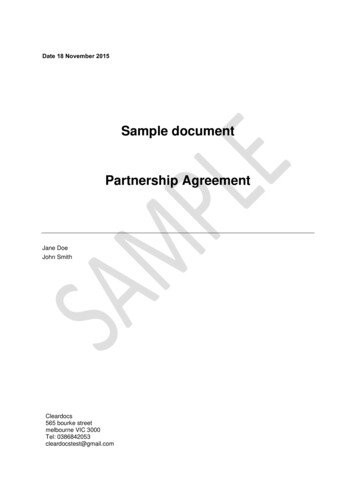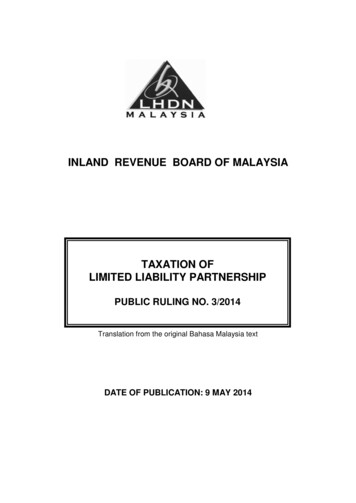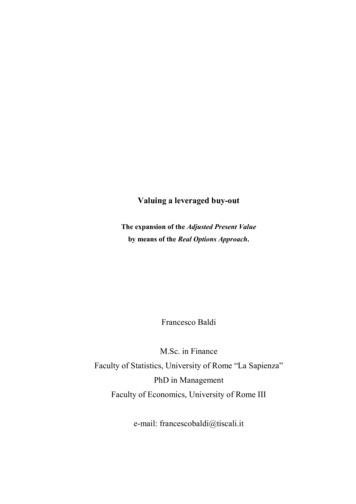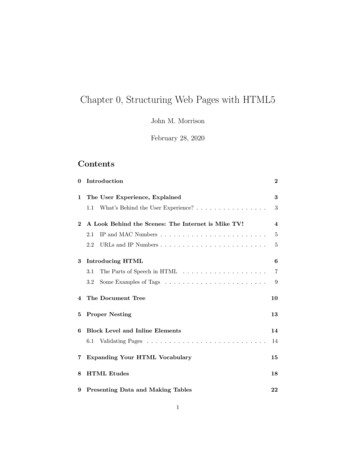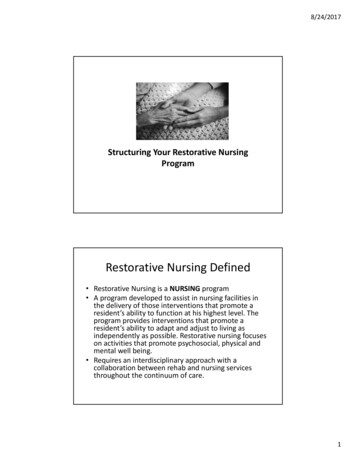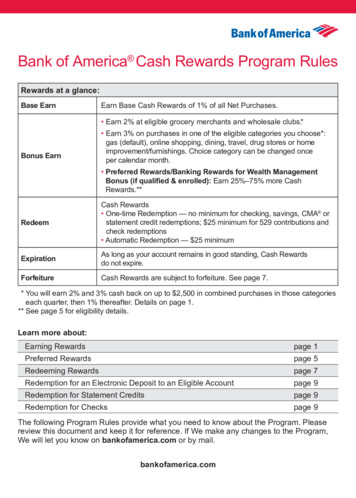
Transcription
Presenting a live 90-minute webinar with interactive Q&AStructuring Redemptions of Partnership andLLC Interests: Issues Unique to LiquidatingDistributionsIRC 754 Elections, Section 736(b) Payments, Character and Timing of Gain, Installment Sales, and MoreWEDNESDAY, FEBRUARY 13, 20191pm Eastern 12pm Central 11am Mountain 10am PacificToday’s faculty features:Michelle M. Jewett, Partner, Stroock & Stroock & Lavan, New YorkGrace Kim, Principal, Grant Thornton, Washington, D.C.The audio portion of the conference may be accessed via the telephone or by using your computer'sspeakers. Please refer to the instructions emailed to registrants for additional information. If youhave any questions, please contact Customer Service at 1-800-926-7926 ext. 1.NOTE: If you are seeking CPE credit, you must listen via your computer — phone listening is nolonger permitted.
Tips for Optimal QualityFOR LIVE EVENT ONLYSound QualityIf you are listening via your computer speakers, please note that the qualityof your sound will vary depending on the speed and quality of your internet connection.If the sound quality is not satisfactory, you may listen via the phone: dial1-888-450-9970 and enter your PIN when prompted. Otherwise, pleasesend us a chat or e-mail sound@straffordpub.com immediately so we can address theproblem.If you dialed in and have any difficulties during the call, press *0 for assistance.NOTE: If you are seeking CPE credit, you must listen via your computer — phonelistening is no longer permitted.Viewing QualityTo maximize your screen, press the F11 key on your keyboard. To exit full screen,press the F11 key again.
Continuing Education CreditsFOR LIVE EVENT ONLYIn order for us to process your continuing education credit, you must confirm yourparticipation in this webinar by completing and submitting the AttendanceAffirmation/Evaluation after the webinar.A link to the Attendance Affirmation/Evaluation will be in the thank you email that youwill receive immediately following the program.For CPE credits, attendees must participate until the end of the Q&A session andrespond to five prompts during the program plus a single verification code. In addition,you must confirm your participation by completing and submitting an AttendanceAffirmation/Evaluation after the webinar.For additional information about continuing education, call us at 1-800-926-7926 ext. 2.
Program MaterialsFOR LIVE EVENT ONLYIf you have not printed the conference materials for this program, pleasecomplete the following steps: Click on the symbol next to “Conference Materials” in the middle of the lefthand column on your screen. Click on the tab labeled “Handouts” that appears, and there you will see aPDF of the slides for today's program. Double click on the PDF and a separate page will open. Print the slides by clicking on the printer icon.
STRUCTURING REDEMPTIONS OF PARTNERSHIP AND LLC INTERESTS:NAVIGATING ISSUES UNIQUE TO LIQUIDATING DISTRIBUTIONSFEBRUARY 13, 2019Presented byMichelle M. Jewett, Partner at Stroock & Stroock & LavanH. Grace Kim, Principal, Grant Thornton LLPStroock & Stroock & Lavan LLPNew York Miami Los Angeles Washington, D.C.5
OUTLINE Key Differences in Treatment of Sales vs. RedemptionsOverview of Partnership Redemption Rules under Code Section 736Liquidating Distributions of “Property” Rather than CashRedeeming a Partner with the Partnership’s NoteStuffing Allocations Prior to Redemption6
KEY DIFFERENCES IN TREATMENT OF SALES VS.REDEMPTIONS: INITIAL DECISION Redemption – a payment made by a partnership to a partner (or deceasedpartner's successor) in liquidation of his/her entire interest in the partnership.BA C50%InterestABC7
KEY DIFFERENCES IN TREATMENT OF SALES VS.REDEMPTIONS: INITIAL DECISION Sale of partnership interest– a payment (or series of payments) made by apartner to another partner (or deceased partner’s successor) to purchasehis/her entire interest in the partnership.BA50%Interest CABC8
KEY DIFFERENCES IN TREATMENT OF SALES VS.REDEMPTIONS Partnership Interest Sale vs. Redemption Characterization Form typically governs characterization – make sure that documentation is consistent withintention for sale or redemption of interest. Flexibility to choose between a sale of a partnership interest vs a complete redemption.See Foxman v. Commissioner, 41 T.C. 535 (1964), aff'd, 352 F.2d 466 (3d Cir. 1965). But watch for possible recharacterization as disguised sale of partnership interest Under proposed § 707 Regulations (withdrawn), withdrawing partners generally wouldbe treated as selling their partnership interests to continuing partners, rather thanreceiving liquidating distributions, where (1) the continuing partners make relatedcontributions to the partnership and (2) based on all the facts and circumstances, thedistributions to the withdrawing partners would not have been made but for thecontinuing partners’ related contributions. If the proportionate interests of some partners but not all partners increase, thissuggests that the transaction was a sale.10
KEY DIFFERENCES IN TREATMENT OF SALES VS.REDEMPTIONS What about two-person partnerships (i.e., one person buying all thepartnership interests)? Rev. Rul. 99-6, Situation 1 (one partner purchases interest of other partner): Purchaser: deemed liquidating distribution of the partnership’s assets to both partners,followed by seller selling portion of partnership assets to purchaser. Seller: sale of partnership interest. What if this is structured as a redemption? Rev. Rul. 99-6, Situation 2 (both partners sell their interests to unrelated third party who isnot already a partner): Purchaser: deemed liquidating distribution of partnership assets to partners,immediately followed by purchaser acquiring, by purchase, all of the formerpartnership’s assets. Sellers: sale of partnership interests.11
KEY DIFFERENCES IN TREATMENT OF SALES VS.REDEMPTIONS Application of Section 751 “Hot Asset” Rules Sale: Section 751(a) may result in a portion of the amount realized on sale as being ordinary gain or lossinstead of capital gain or loss. Partner’s share of ordinary income/loss on sale of partnership interest is equal to the partner’s shareof partnership’s ordinary income/loss (i.e., ordinary income/loss attributable to so-called “hot assets”);remainder of partner's gain/loss on sale of partnership interest is capital gain/loss. Hot assets are comprised of inventory and unrealized receivables (e.g., supply/service contracts;recapture items (Sections 1245, 1248, 1254, etc.); accounts receivable of a cash-basis partnership). Redemption: Section 751(b) applies through a deemed sale transaction giving the partnership a step-upin tax basis in the assets deemed to be sold (even if no Section 754 election has been made). Section 751(b) only applies if the distributee partner’s interest in the gross value of one class ofproperty (i.e. “hot assets” and property other than “hot assets”) increases and his interest in thegross value of the other class decreases. The Section 751(b) rules apply first by treating a portion of the distribution as a sale or exchange ofthe excess distribution property for the other property between the distributee partner and thepartnership. Section 751(b) applies to narrower scope of inventory--it only applies to “substantially appreciated”inventory in a redemption. The higher tax rate on Section 1250 unrecaptured gain applies in a sale but not in a redemption of apartnership interest.12
KEY DIFFERENCES IN TREATMENT OF SALES VS.REDEMPTIONS Installment Sales Sale of partnership interest: gain or loss is recognized over period in which payments are made under theinstallment method of Section 453. Must recover a pro-rata portion of outside basis with each payment. See Rev. Rul. 84-53. But installment sale treatment is not available for gain attributable to hot assets (see Rev. Rul. 89-108; Mingov. Commissioner, 773 F.3d 629 (5th Cir. 2014), aff'g 105 TCM 1857 (2013); and CCA 200722027 (Apr. 27,2007). Redemption: basis can be recovered before gain is recognized but loss is deferred until final payment, and thereis no imputed interest. Another important difference in the treatment of installment sales and redemptions is that, for redemptions, thepartner is treated as continuing to be a partner until the last payment is received whereas for sales the sellingpartner ceases to be a partner when the sale occurs. Goodwill Sale of partnership interest: for seller, generally part of capital gain underlying partnership interest; for purchaser,possible recovery via basis adjustment Redemption: the treatment of the redeemed partner and the remaining partners depends on whether (i) thepartnership is a service partnership, (ii) the redeemed partner is a GP or LP, and (iii) the partnership agreementprovides for payments with respect to goodwill (see discussion Section 736, below).13
KEY DIFFERENCES IN TREATMENT OF SALES VS.REDEMPTIONS Basis Adjustments Sale: if a section 754 election is in effect, the purchasing partners have a basis adjustment underSection 743(b) in their respective share of the basis of the partnership’s assets that generallysimulates a purchase of assets. The basis adjustment is available even if subsequent payments will be made as part of aninstallment sale. The basis adjustment applies only for the transferee; it is not common basis. The basis adjustment looks to the amount of tax gain/loss that would be allocated with regardto the sold interest upon a hypothetical sale of assets at FMV; it is not computed based on theamount of the seller’s gain/loss recognized. The overall basis adjustment amount is allocated among all the partnership’s assets inaccordance section 755 regulations (based on hypothetical sale of assets at FMV).– Depending on asset values and their unrealized appreciation or depreciation, the basis adjustment for aparticular property could be a step up or a step down. Section 743(b) basis adjustment is mandatory (i.e., applies even if no section 754 election isin effect) where the partnership has a substantial built-in loss (i.e., partnership's adjusted basisin all partnership property exceeds FMV of such property by more than 250K).14
KEY DIFFERENCES IN TREATMENT OF SALES VS.REDEMPTIONS Basis Adjustments (cont’d) Redemption: in certain circumstances, partnership adjusts the basis of its assets Step-up in the tax basis of its section 751(b) “hot assets” arising from hot asset exchange. If a section 754 election is in effect, in certain distribution situations there is a basis adjustmentunder section 734(b) to the common basis of partnership’s assets:– if an amount of money is distributed that exceeds the redeemed partner’s basis in his partnership interestand the redeemed partner recognizes gain (only when the partner recognizes gain in case of aninstallment sale),– if a partnership interest is completely liquidated solely in exchange for money, unrealized receivables, andinventory, and the redeemed partner recognizes a loss,– if the partnership’s basis in assets distributed to a partner exceeds the redeemed partner’s basis in hisinterest, or– if a redeemed partner’s interest is completely liquidated and the aggregate basis of distributed assets inhis hands is greater than the partnership’s predistribution basis in the assets. The basis adjustment is applicable to the partnership’s property and all remaining partners areaffected. Also, section 734(b) adjustment is mandatory (even in the absence of a section 754 election),where there is a "substantial basis reduction" (i.e., where distribution results in loss undersection 731(a) in excess of 250K or increase in basis of property distributed in hands ofdistributee in excess of 250K)15
KEY DIFFERENCES IN TREATMENT OF SALES VS.REDEMPTIONS Other considerations Potential application of self-employment taxes. Closing of tax year with respect to partner whose interest is redeemed. Allocations for pre and post redemption (pro ration vs closing of the books). Timing of recognition of suspended losses under passive loss rules. Revaluations and corresponding capital account adjustments. Technical termination considerations (repealed for partnership tax years beginning after12/31/17).16
OVERVIEW OF PARTNERSHIP REDEMPTION RULESUNDER CODE SECTION 736 Payments made by a partnership to a partner (or deceased partner’s successor) inliquidation of his/her entire interest in the partnership.BA C50%InterestABC
OVERVIEW OF PARTNERSHIP REDEMPTION RULESUNDER CODE SECTION 736 Section 736 applies to payments made by a partnership to a retired or adeceased partner’s successor in interest in liquidation of his entire interest in thepartnership (Reg. section 1.736-1(a)(1)(i)). Partner is treated as retiring only when he ceases to be a partner under local law (Reg. section1.736-1(a)(1)(ii)). But the retiring partner is regarded as a partner for U.S. federal income tax purposes until theentire interest is liquidated (Reg. section 1.736-1(a)(6)) . Means that a 2-person partnership continues for US federal income tax purposes until the lastpayment is made to the redeemed partner. Taxable year of a partnership does not terminate with respect to a retired partner until all 736payments have been made. Even though a retired partner may not be entitled to a distributive share of partnership income,forward and reverse Section 704(c) allocations still continue to apply to such partner. Amounts distributed include any deemed distributions under section 752(b) as a result of adecrease in the redeemed partner’s share of the partnership’s liabilities.18
OVERVIEW OF PARTNERSHIP REDEMPTION RULESUNDER CODE SECTION 736 Section 736 performs at least two tasks: Characterizes payments made to a retiring partner based on the nature of the payment; Provides timing rules for multi-year payments; Provides allocation rules for each payment if not agreed to by the partners. Section 736 does not alter the total amount of income/gain to be recognizedby the redeemed partner. Section 736 does not determine value of partnership property, hot assets,etc. Generally, the valuation placed upon a partner's interest in partnership property in anarm's length agreement will be regarded as correct (Reg. section 1.736-1(b)(1)). Generally, the 736 rules look to gross value, rather than net value.19
OVERVIEW OF PARTNERSHIP REDEMPTION RULESUNDER CODE SECTION 736 Section 736 divides partnership withdrawal payments between: (i) payments under Section 736(a) which are generally income to the redeemed partnerand deductible (or excludible from income) for the remaining partners; and (ii) payments covered under Section 736(b) which are generally considered payments forthe redeemed partner’s interest in the partnership assets and result in gain or loss to suchpartner but are not deductible for the remaining partners. The redeemed partner and the remaining partners have flexibility indetermining what portion of total liquidating payments is attributable tosection 736(b) property and what portion is taxable under Section 736(a).20
OVERVIEW OF PARTNERSHIP REDEMPTION RULESUNDER CODE SECTION 736 Section 736(b) Payments Generally consist of all liquidation payments to the redeemed partner that are in exchange for thepartner’s interest in partnership assets. For this purpose a partner’s share of the partnership’s assets is determined based on gross,rather than net, value. The tax consequences are determined by the normal partnership distribution rules (including thehot asset rules under Section 751(b)). Section 736(b) payments result in gain only to the extent that the amount of cash distributedexceeds the redeemed partner’s basis and result in loss only when the liquidating distribution islimited to cash, unrealized receivables, and/or inventory. Generally, any gain or loss is characterized as capital in nature (except for ordinary incometreatment under Section 751(b)). Payments are not deductible by the partnership, and the basis of remaining partnership assets isadjusted only if: the partnership has made a Section 754 election or a portion of the distribution is characterized as a sale or exchange under Section 751(b).21
OVERVIEW OF PARTNERSHIP REDEMPTION RULESUNDER SECTION 736 Section 736(a) Payments Payments made to a partner classified as a “general partner” in partnership in which capital is nota material income producing factor (i.e., a service partnership) for: Unrealized receivables (not including depreciation recapture gain and similar items) and Payments for the goodwill of the partnership to the extent that the partnership agreement doesnot expressly provide for goodwill payments. The third category of Section 736(a) payments consists of liquidation payments in excess of thevalue of the redeemed partner’s interest. Section 736(a) payments are characterized either as (i) a distributive share of partnership incomeor (ii)“guaranteed payments” depending on whether the payments are determined based on thepartnership’s income. Guaranteed payments are ordinary income to the redeemed partner and are deductible by thepartnership. A distributive share may include capital gain or other tax-favored income, as well as ordinaryincome, and reduces the other partners’ shares of partnership income.22
OVERVIEW OF PARTNERSHIP REDEMPTION RULESUNDER SECTION 736 The characterization of payments made in redemption of a partner’s interestin installments over several taxable years as between Section 736(a) andSection 736(b) depends on whether the payments are contingent or fixed. Timing Rule: Payments received over more than one year must be allocatedbetween section 736(a) and section 736(b) payments. Fixed Amounts: If the payment is for a fixed amount over a fixed number of years, the portion treated asa section 736(b) payment bears the same ratio to the total fixed agreed payments forthe year as the total fixed agreed payments under section 736(b) bear to the total fixedagreed payments under section 736 (a) and (b). The balance, if any, of the payment received during the year is treated as a distributiveshare or a guaranteed payment under section 736(a). Reg. section 1.736-1(b)(5)(I). Special rule if the actual amount received in a year is less than the amount consideredto be that year's section 736(b) distribution: any unapplied portion is to be added to theportion of the payments for the following year(s) which are treated as a distributionunder section 736(b).23
OVERVIEW OF PARTNERSHIP REDEMPTION RULESUNDER SECTION 736 Timing rule (cont’d): Contingent payments: Section 736(b) payments first to the extent of the value of the partner’s interest in partnershipproperty; and Section 736(a) payments to the extent of the balance. See Reg. section 1.736-1(b)(5)(ii) Partially Fixed/Partially Contingent Payments: If the fixed payments exceed the partner's interest in section 736(b) property, then a portion offixed payment and all contingent payments are treated as section 736(a) payments. If the interest in section 736(b) property exceeds the fixed payments, all fixed payments aretreated as section 736(b) payments, and contingent payments are allocated first to thebalance of the value of the retiring partner's interest in section 736(b) property and then tosection 736(a) payments. Election: Allocation may be made in any manner to which all the remaining partners and thewithdrawing partner agree, provided that the total amount allocated to property under Section736(b) does not exceed the fair market value of such property.24
OVERVIEW OF PARTNERSHIP REDEMPTIONRULES UNDER SECTION 736 Timing rule example: Partner retires when the agreed value of his interest insection 736(b) property is 60k. In liquidation, he receives 90k in 10 equalinstallments. Of each 9k installment, 6k is a section 736(b) payment and 3k is a section 736(a)(2) guaranteed payment.25
EXAMPLE—SECTION 736 RETIREMENT PAYMENT Facts:o Partnership ABC is a personal service partnership.o Partner A is a general partner and retires from the partnership in accordance with an agreementwhereby his share of partnership liabilities ( 1,000) is assumed by the partnership.o The partnership agreement contains a provision that the payment for A's interest in partnershipproperty shall include payment for his interest in the goodwill of the partnership.o A and the partnership agree that A will receive 9,000 in the year of retirement plus 10,000 in thenext two succeeding years for a total of 29,000 ( 30,000 when 1,000 relief of liability isincluded). This amount exceeds A’s share of the FMV of the partnership property.27
EXAMPLE—SECTION 736 RETIREMENT PAYMENT(CONT'D)TaxFMVTaxFMV 13,000 13,000Liabilities 3,000 3,000-0UnrealizedReceivables 30,000A 10,000 24,000 20,000Capital &1231 Assets 23,000B 10,000 24,000Goodwill-0- 9,000C 10,000 24,000Total 33,000 75,000Total 33,000 75,000Cash28
EXAMPLE—SECTION 736 RETIREMENT PAYMENT(CONT'D)Cash29,000Relief of Debt 1,000Total Consideration736(a) and (b) Amounts 30,0001/3 Interest Cash 4,333.33 (736(b))1/3 Interest Capital & 1231 Assets 7,666.67 (736(b))1/3 Interest Goodwill 3,000 (736(b))1/3 Interest URs 10,000 (736(a))Total Interest 736(b) Property 15,000736(a) Payments ( 30,000 less 15,000) 15,00029
EXAMPLE—SECTION 736 RETIREMENT PAYMENT(CONT'D) Determining overall ratio of section 736(b) payments to total payments: 15,000/ 30,000 1/2 From the disposition of A's interest in property, A will realize an overall capital gain of 4,000 relatingto the section 736(b) piece 15,000 section 736(b) paymentminus 11,000 outside basis ( 10,000 tax capital 1,000 share of debt) 4,000 capital gain overall (gain under section 731(a)) The remaining 15,000 will constitute payments under section 736(a)(2), which are taxable to A asguaranteed payments under section 707(c) and deductible by the partnership 30,000 total consideration, less 15,000 736(b) payments 15,000 guaranteed payment30
EXAMPLE—SECTION 736 RETIREMENT PAYMENT(CONT'D)Year 1 Cash 9,000736(a) and (b) AmountsYear 1 Relief of Debt 1,000Total Year 1 Consideration 10,000736(b) payment (defaultallocation) 10,000 payment x 15,000736(b) property/30,000 Total 5,000 736(b) Payment736(a) payment (defaultallocation) 10,000 payment x 15,000736(a) payments/30,000 Total 5,000 736(a)(2) GuaranteedPayment31
EXAMPLE—SECTION 736 RETIREMENT PAYMENT(CONT'D)Partner AYear 1 – GuaranteedPayment 5,000Year 1 – Outside Basis 11,000 ( 10,000 1,000Share of Debt)Less relief of Debt 1,000 Less Cash Distribution 4,000 EOY Basis 6,00032
EXAMPLE—SECTION 736 RETIREMENT PAYMENT(CONT'D)Partner AYear 2 – GuaranteedPayment 5,000Year 2 – Outside Basis 6,000Less relief of Debt-0-Less Cash Distribution 5,000 EOY Basis 1,00033
EXAMPLE—SECTION 736 RETIREMENT PAYMENT(CONT'D)Partner AYear 3 – GuaranteedPayment 5,000Year 3 – Outside Basis 1,000Less relief of Debt-0-Less Cash Distribution 5,000 EOY Basis -0-731(a) Gain on Distribution 4,00034
EXAMPLE—SECTION 736 RETIREMENT PAYMENT(CONT'D) Additional Considerations:o If Partnership ABC has a section 754 election in effect, a section 734(b) adjustment to commonbasis is to be made in year 3.o If Partnership ABC's partnership agreement does not provide for the treatment of goodwill, thenonly 40% of each year's payment would be a section 736(b) payment.o This example has not included any hot assets other than unrealized receivables, which are to betreated as section 736(a)(2) payments under the facts of this example. However, if there are recapture items or substantially appreciated inventory in Partnership ABC,then a section 751(b) analysis may need to be done.35
LIQUIDATING DISTRIBUTIONS OF “PROPERTY” RATHERTHAN CASH It is not entirely clear that Section 736 applies to property distributions(although its application is assumed in the Section 751 regulations). Assuming that it does apply, the tax treatment would be expected to differdepending on whether there are “unrealized receivables” under Section751(b) and whether there are any Section 736(a) payments. No unrealized receivables or Section 736(a) payments: if cash received does not exceedpartner’s basis in partnership interest, no gain is recognized and redeemed partner takesa tax basis in the property equal to the difference between the amount of cash distributedand his tax basis. Otherwise: incredible complexity and uncertainty regarding allocation of distribution toSection 736(a) property and Section 736(b) property, treatment of distribution of unrealizedreceivables (particularly if coupled with a distribution of other assets), and uncertainty ifdistribution is characterized as a distributive share of partnership income. Unfortunately there is no clear guidance on these issues.36
REDEEMING A PARTNER WITH THE PARTNERSHIP’S NOTE What is the treatment under the distribution rules of a redemption using thepartnership’s note? Is it a mere change in distribution rights (retired partner has deferred distribution right) or aproperty distribution? 704(b) capital accounting concepts—should they be applied for doing the analysis underthe distribution rules? Under the 704(b) regulations, the withdrawing partner continues to have a capitalaccount until there is a taxable disposition of the note or when the partnership makesprincipal payments on the note. Reg. section 1.704-1(b)(2)(iv)(e)(2). But the withdrawing partner's capital account is decreased by the FMV of any negotiablepromissory note distributed– What is the definition of negotiable for this purpose?37
REDEEMING A PARTNER WITH THE PARTNERSHIP’S NOTE Does the 704(b) regulations’ approach provide a framework for a closed vsopen transaction analysis? Closed transaction (partner's interest is fully liquidated and partner is no longer a partnerfor US federal income tax purposes)—partnership distributes a negotiable note or a readilytradable note. Open transaction (partner's interest is liquidated over time)—partnership distributes anonnegotiable note. Retiring partner receives distributions under section 731. Section 734(b) adjustment available each time there is 731(a) gain. Is the partnership's note property? If so, what is its basis? IRS seems to have indicated it is not property. See FSA 1999-1084 (heavily redacted). Corporate analogy? See Peracchi v. Commissioner, 143 F.3d 487 (9th Cir. 1998);Lessinger v. Commissioner, 872 F.2d 519 (2d Cir. 1989). What if the note is a demand note?38
STUFFING ALLOCATIONS PRIOR TO REDEMPTION Many hedge funds use so-called “stuffing” or “fill-up” allocations which are a one-time specialallocation of realized gain or loss to a partner immediately prior to that partner's redemption. Most hedge funds do not make Section 754 elections because of the administrative costs if thereare frequent redemptions and admissions of new partners and because many hedge funds canmake a mark-to-market election under Section 475(f). The goal of the special allocation is to cause the partner’s tax capital account and tax basis ata level equal to what the partner receives on redemption of its interest so that the partnerrecognizes no additional gain in connection with the distribution in redemption of his interest. A stuffing allocation reduces the amount of partnership income or gain allocated to continuingpartners by disproportionately allocating partnership gain or income to the redeemed partner. There is uncertainty regarding whether would be viewed as violating the principles of Section704(c) or could be subject to challenge under the partnership anti-abuse rules.39
NO TAX OR OTHER PROFESSIONAL ADVICE BEINGPROVIDED The views and statements expressed by the panelists are those of the panelists individually, and do notnecessarily represent the views or statements of any firm or agency by which they may be employed. This publication contains general information only and the panelists in this presentation are not, by means ofthis publication, rendering accounting, business, financial, investment, legal, tax, or other professional adviceor services. The information contained in this presentation provides background information about certainlegal and accounting issues and should not be regarded as rendering legal or accounting advice to any personor entity. As such, the information is not privileged and does not create an attorney-client relationship oraccountant-client relationship with any firm or agency represented here, or any of its employees. Thispresentation does not constitute an offer to represent you, and you should not act, or refrain from acting,based upon any information so provided. In addition, the information contained in this presentation is notspecific to any particular case or situation and may not reflect the most current legal developments, verdicts,or settlements. Nothing herein shall be construed as imposing a limitation on any person from disclosing the tax treatment ortax structure of any matter addressed herein.40
Michelle Jewett212-806-5835mjewett@stroock.comGrace Kim202-521-1590grace.kim@us.gt.com For more than 140 years we have partnered with our clients to ensure their continued success. We are firmlycommitted to helping our clients achieve their business goals. We work together as a team of lawyersdelivering practical, results-driven guidance to find the most creative and effective solutions.41
If you dialed in and have any difficulties during the call, press *0 for assistance. NOTE: If you are seeking CPE credit, you must listen via your computer —phone listening is no longer permitted. Viewing Quality To maximize your screen, press the F11 key on your keyboard. To exit
